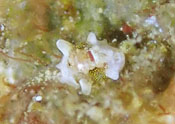| Home |
| Acknowledgments |
| Conventions |
| Glossary |
| Maps |
| References |
| Links |
| Articles |
| Thumbnails |
| Species
list |
| Velutinidae |
| Eratoidae |
| Triviidae |
| Ovulidae |
| Marginellidae |
| Cystiscidae |

Prosobranch Addendum
| The prosobranch gastropods
aren't closely related to the
heterobranchia. So, they're technically
outside the scope of this site. Most are readily distinguished from the
opisthobranchs. However, a few families are often mistaken for them and
we've added this addendum to illustrate the Hawaiian species in some of
them The following information is based primarily on Kay, 1979 and whatever we've been able to pick up on-line. Unlike the opisthobranchs, we haven't kept extensive notes on these families--no running log of finds or detailed records of the source of photographed animals. So, we can't guarantee that it includes the latest names and it may not be as comprehensive as the opisthobranch section. |
Velutinidae
| Velutinids
are prosobranch gastropods of the family Velutinidae (sometimes
referred to as the Lamellariidae). They have an internal
shell that is covered by the mantle (which is often elaborately colored
or ornamented). They are frequently mistaken for dorid nudibranchs or
pleurobranchids but may be distinguished from both groups by
their unrolled cephalic tentacles that emerge from
beneath the mantle and have bulbous eye spots at their bases. In
contrast, dorids have rhinophores emerging from the top of the mantle
and pleurobranchids have rolled rhinophores that emerge from beneath
the mantle. They feed on colonial tunicates and are often very cryptic
when seen on their hosts. Many velutinids are also highly variable in
color and/or texture
making identification difficult. There are probably about 14
species known from Hawaii in,
perhaps, three genera: Coriocella,
Hainotis and
Lamellaria. Fassio, et. al. (2023) provides some genetic work for the family. However, we're uncertain how it applies to the Hawaiian species. |
| In addition to the Velutinidae, there are four other families that are included in the superfamily Cypraeoidea:
Cypreidae, Ovulidae, Eratoidae and Triviidae. Although they have
external shells, they share the characteristic of being able to cover
their entire shell with their mantle. The best known are the Cypreidae
or cowries. They are extensively covered, elsewhere (for example, by Scott Johnson here). So, we're not
including them at this time. The Hawaiian Ovulidae are generally
confined to water deeper than 50 m (in association with Gorgonians) and
are unlikely to be seen by recreational divers. However, Hawaiian Eratoidae and Triviidae have
seldom been illustrated and are found in shallow water. |
Eratoidae
| The Eratoidae are small snails with visible apexes when adult. They feed
on compound ascidians. Only one species is known from Hawaii in the genus Eratoena. The family was previously included in the Triviidae. |
|
Triviidae
| The Triviidae include small
cowrie-like species found in both rocky habitats and Halimeda kanaloana
beds. Like cowries, they start out as "typically-shaped"
snails, then transform into an adult form in which the aperture is
restricted to a narrow slit and the apex is obscured. The
size at maturity is variable and the number of ribs, depth of the dorsal
sulcus and development of the lateral callous vary with age. They feed
on compound ascidians.
There
are at least four species in Hawaii in the genera Cleotrivia, Purpurcapsula and Trivirostra. Due to uncertainty in the nomenclature, we are adopting the genera used in Severns, 2011 but retaining the combinations used in Kay, 1979 (pending further clarification). |
 Cleotrivia globosa |  Purpurcapsula exigua |  Trivirostra edgari |  Trivirostra hordacea |
Ovulidae
| The Ovulidae are relatives
of cowries that, in Hawaii, are confined to deep water. However, a
juvenile(?) that may be a member of the genus Margovula (ID uncertain) was recently found in shallow water. They feed on Gorgonians. |
 Margovula(?) sp. #1 |
| The following two families
are not closely related to the velutinids. But, due to their transparent
shells and small size they are occasionally mistaken for
cephelaspideans. |
Marginellidae
| The family Marginellidae
includes small transparent to translucent snails with well-defined
columellar folds. There are four species known from Hawaii in the
genera Dentimargo, Granulina and Volvarina. |
 Dentimargo pumila |  Granulina vitrea |  Granulina(?) sp. #1 |  Volvarina unilineata |
Cystiscidae
| The family Cystiscidae
includes small transparent to translucent snails with well-defined
columellar folds. The body of the animal showing through the shell is
often strikingly patterned. There are at least four species known from Hawaii including
the
genera Crithe and Cysticus. Until recently these species were placed in the Marginellidae. |
 Crithe huna |  Crithe sp. #1 |  Cystiscus sandwicensis |  un. sp. #1 |
| Thumbnails |
Species
list |
Top |













